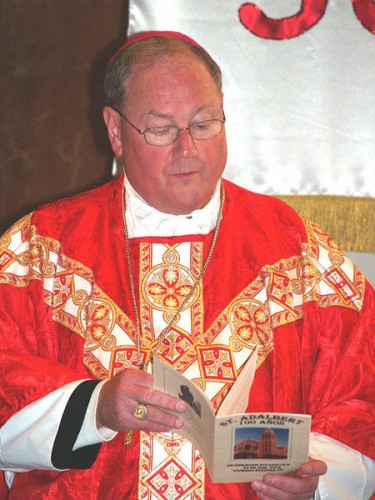 Pope Benedict XVI named 22 new cardinals today, forming the "electoral college" that picks the next pope. John Allen offers general observations on the announcement, but he and other reporters are especially zeroing in on Archbishop Timothy Dolan of New York, who was elected president of the U.S. Conference of Catholic Bishops last year.
Pope Benedict XVI named 22 new cardinals today, forming the "electoral college" that picks the next pope. John Allen offers general observations on the announcement, but he and other reporters are especially zeroing in on Archbishop Timothy Dolan of New York, who was elected president of the U.S. Conference of Catholic Bishops last year.
The news offers New York publications the chance to dig into how Dolan has adapted from Milwaukee to New York and how his prominence has risen on a national level. On cue, the New York Times' profile of the cardinal pick launches with a grand statement about the Catholic church in America.
IT is not a good time for the Roman Catholic Church in America, but Cardinal-designate Timothy M. Dolan has made it his mission to remind people that there is more to the church than scandal. Taping his weekly radio show last month, he praised the beauty of a recent church service in Yonkers, and recounted an emotional visit to the solitary confinement wing at Rikers Island.
It's surprising to me that a piece like this would make assumptions about whether it's a good or a bad time for the Catholic church without adding a bit more to back it up. Perhaps it could talk about the sex abuse allegations, but the pronouncement offers the reader little context.
Archbishop Dolan is not well-known outside of religious circles. And the question remains whether this distracted, liberal, scandal-weary city is willing to listen to a conservative voice even as entertaining as his.
Since arriving in New York from Milwaukee, Archbishop Dolan, who was born in Ballwin, Mo., has most often caught the public’s attention as the traditional unyielding Catholic voice of “no” — to same-sex marriage, to abortion, and to sex education in public schools.
Dolan is often in the news (especially with New York's gay marriage vote), but the reporter just assumes he's not well-known to those outside of religious circles. If he isn't, why doesn't the profile spend a little more time explaining his background, going into more depth on what led him to church leadership? And is he known as the voice of "no" on those issues, or is that how media outlets like the Times portray him?
The piece spends most of its time describing Dolan as a warm and funny guy that doesn't budge on doctrine or social issues and wants to reform the image of the church.
But his goal is even larger: to be a force for restoring the image of the Catholic Church in America in the wake of the sexual abuse crisis.
“What weighs on me the most,” he said in an interview in December, “is the caricature of the Catholic Church as crabby, nay-saying, down in the dumps, discouraging, on the run. And I’m thinking if there is anything that should be upbeat, affirming, positive, joyful — it should be people of faith.”
The reporter stresses his image through his radio show and the Catholic Church's image but it doesn't really offer anything new that I can tell. I do love this anecdote at the end, which could have been brought up even higher.
Ever the faithful Catholic, he is quick to stress that humor — and the faith and hope he says undergird it — is a gift from above. And humor is present at even the highest level of the church, Archbishop Dolan said, illustrating that assertion with a story about his visit to Pope John Paul II in 2004 to report on the state of the Milwaukee archdiocese.
“I said, ‘Holy Father, we have good news. The Archdiocese of Milwaukee is growing’,” he said.
The pope stopped and said — and here the archbishop switched into an impression of the pope’s throaty Polish accent — “So is its archbishop.”
Then the archbishop let out his signature hearty belly laugh, as if to prove the pope’s point.
“I said, ‘Holy Father,’ ” he continued, “ ‘please assure me that is not an infallible statement.’ ”
This adds some color and a fun story to remember about Dolan. Still, the piece could have offered more details about the archbishop's background, the state of the Catholic church, and the significance of being named a cardinal, pieces of information that fill out a basic profile. The piece just doesn't get beneath image to much substance.
